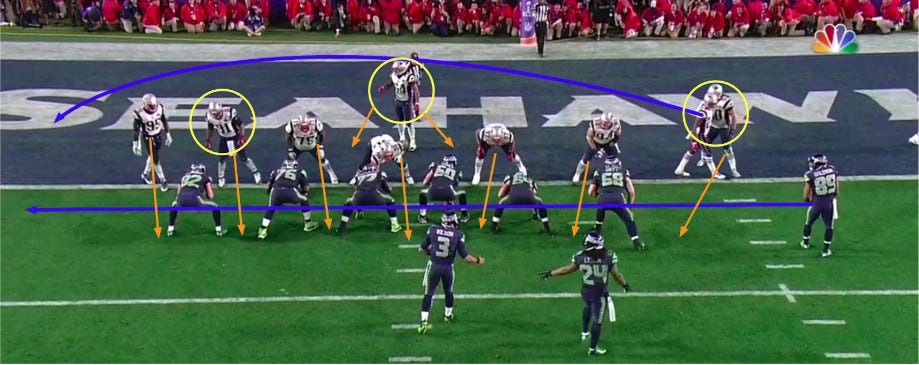You Make the Call
Revisiting the NE Patriots vs Seattle Super Bowl
Being a Hockey IQ newsletter, we can’t possibly skip over the art of decision-making. So let’s dive into it!
The world is governed by probability, but people think in black and white.
Right or wrong
Win or loss
Did it happen/did it not?
Why do we do this? … because it’s easier. We are lazy. Yet, as we age and mature, it’s very clear the world is not black and white. There are shades of gray that must be navigated.
The best decision-makers are in the business of making decisions that put the odds in their favor. While the decisions are made in the fog and hindsight is 20/20, there are ways to give yourself the best chance of success.
To best illustrate this point, let’s breakdown the famous Super Bowl matchup between the New England Patriots vs Seattle Seahawks.
Breaking it down
The NE Patriots lead 28-24 after scoring a touchdown. Seattle drove down the field from their own 20-yard line. They needed a touchdown as nothing less would do.
QB Russell Wilson connected on a pass to Marshawn Lynch to the Patriots 49-yard line
Wilson passed to Doug Baldwin to the Patriots 38-yard line
Wilson passed to Jermaine Kearse to the Patriots 5-yard line. He was pushed out of bounds with 1:06 left on the clock.
They ran the ball with Marshawn Lynch to the 5-yard line. The clock was ticking.
As the clock ran down, the Patriots declined to take a timeout. Taking a timeout would have saved them time to go down and score if Seattle scored a touchdown to take the lead (Note: letting the other team score and saving time for their own offense is actually a tactic the Patriots had used in a previous Super Bowl vs. the NY Giants).
You’re Seattle’s head coach, Pete Carroll. What do you do?
Before we get to what happened, there are two ways to look at this. (1) From the meta-game & (2) from the on-field matchups.
Matchup
The Patriots didn’t take the timeout and immediately ran into a defensive look they hadn’t shown often, a goal-line front with a nickel coverage (3 DBs). Meanwhile, the Seahawks stayed in their 11 personnel, and a mismatch was created.
The Patriots were in man-on-man coverage on the outside with no help. Their formation is meant to stop the run. Here is what the matchup looked:
Pretty stifling if you’re going to try and run the ball. There are 8 defenders to 6 available blockers. Advantage defense.
Given matchups, passing the ball was the best option in this situation. Against man coverage, a pick play was a quality choice. At this time the Patriots put in an undrafted rookie with 0 career interceptions, Malcolm Butler.
Quality play call and great matchup to attack. You can see the allure.
Meta-game
Looking at the situation involving the clock and downs makes you think even further. Seahawks head coach Pete Carrol had one timeout and three downs left in which to try and score. He had two options on the next play - run or pass.
If they run on 2nd down and fail, they must call a timeout. In order to preserve all 4 opportunities to score, they would be forced to into an obvious pass play on 3rd down.
If they pass on 2nd down and fail, there is enough time for two plays that can be either pass-run or run-pass or run-run. A more advantageous situation.
Given both the matchups and the meta-game, you’d be inclined to pass the ball. That is what they chose, as well.
The Result
No one thinks that they will throw an interception, just like no one thinks they will fumble.
After the play, color commentator Cris Collinsworth spoke loud and clear, “I cannot believe the call.” Most people in the world immediately drew a conclusion that it was a terrible call not to run the ball with Marshawn ‘Beast Mode’ Lynch. Likely the best power runner in the NFL at the time.
Hindsight is 20/20
As we noted earlier, hindsight is 20/20. Like most decisions, this one was criticized based on the result, not the quality of the decision and the decision-making process.
If it works, the decision was genius; if it didn’t, the decision was a terrible play call.
In reality, it’s all about increasing the probability of success. Pete Carroll gave his team the best chance at winning the game. His decision was solid given what he knew at the time. Without knowing the result, the majority of people would have chosen to pass as well.
Carroll’s thought process was strong. Just because the result didn’t follow didn’t and doesn’t make him a bad decision-maker.
Let’s get a good laugh from this scene from the classic fantasy football comedy series, The League
Realistically, you can make the right call and the result is poor. Or make a terrible call and the result is positive.
Lesson learned: You can’t always tell the quality of a decision from the resulting outcome.
Did You Enjoy This Newsletter?
Help us spread the ideas within and share it with the people you care about


